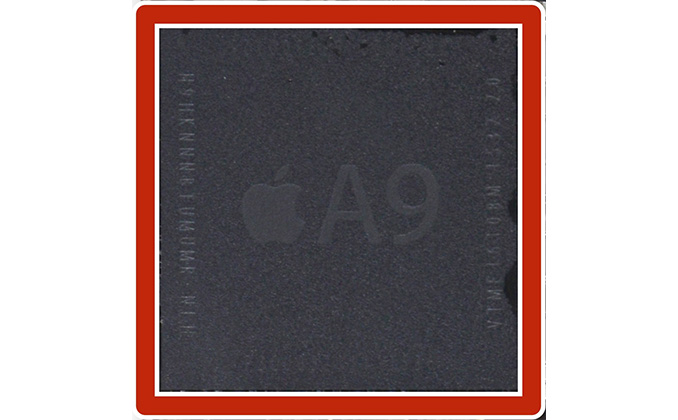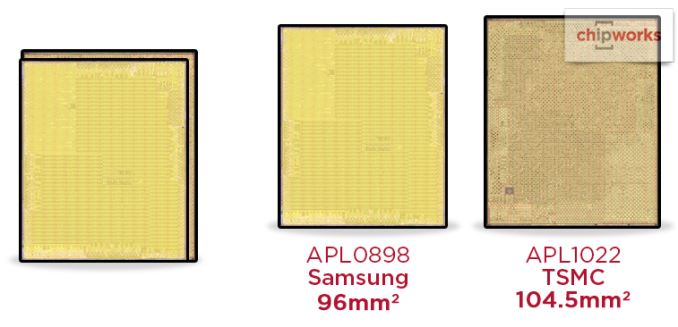Apple’s A9 SoC Is Dual Sourced From Samsung & TSMC
by Ryan Smith on September 28, 2015 7:00 PM EST
Picking up from our conversation this morning on Apple’s A9 SoC, the crew over at Chipworks has been working hard over the weekend to decap A9 and their first results are in. As it turns out, Chipworks has found chips fabbed by both TSMC and Samsung, which means that A9 is in fact a dual sourced part.
In taking apart iPhones and decapping SoCs, Chipworks has turned up two SoCs. The first, APL0898, is a 96mm2 A9 that’s fabbed by Samsung. The second SoC, APL1022, is a 104.5mm2 SoC fabbed by TSMC. And while Chipworks isn’t naming the specific manufacturing processes used, based on Apple’s comments on a “new transistor architecture,” we’re certainly looking at a form of FinFET. In which case the two chips are made on versions of Samsung’s 14nm FinFET and TSMC’s 16nm FinFET processes respectively.
This development is interesting for a few different reasons. From a fabrication standpoint, Samsung and TSMC have been brawling at multiple levels (technical and legal) to be the first to get a next-generation FinFET process out the door, with Samsung ultimately winning that battle when they shipped the 14nm Exynos 7420 for the Galaxy S6 family. For TSMC on the other hand this is as far as we know the first consumer product released with a 16nm TSMC fabbed part, indicating that TSMC is finally able to ship such parts in a reasonable volume.
More importantly, this is a huge move for Apple, and one we admittedly don’t have all of the facts about at this time. Dual sourcing parts is by no means a new concept – IBM requiring a second source of x86 chips is how AMD got started in the x86 industry, after all – but in more modern times dual sourcing of high performance parts is very rare due to how difficult and expensive it is. With dual sourcing essentially requiring the chip to be taped out twice – once for each fab – it requires significant financial and engineering resources, a cost that not very many companies besides Apple can take on without significant risk.
| Apple A9 SoC Versions | ||||
| APL0898 | APL1022 | |||
| Manufacturing Process | Samsung 14nm FinFET | TSMC 16nm FinFET | ||
| Die Size | 96mm2 | 104.5mm2 | ||
The big hurdle with dual sourcing a part such as a cutting-edge SoC like A9 is that unless the source fabs have designed their processes to be near identical – to form a common foundry specification – then different fabs will have different processes with different characteristics. This in turn is determined by the technical decisions a fab made in research and development, and the specific issues the fab ran into when bringing up the new process. The end result being that while two fabs can turn out chips based around the same design, those chips will not be identical. It’s this kind of inconsistency that chip customers like Apple have to tackle head-on if they want to go with dual sourcing.
Even at a physical level we can see this inconsistency right away in terms of die sizes. Despite the TSMC and Samsung processes being quite similar, the Samsung A9 is the smaller of the two by 8%, which as Chipworks notes is indicative of better density on Samsung’s 14nm node. What we don’t see, and the issue Apple really has to control for, is power consumption. Right now it’s a safe assumption that both chips can reach Apple’s required clockspeeds, so in order for Apple to utilize both in the iPhone 6s they need to make sure both perform as identically as possible, especially when it comes to idle power leakage and power consumption at different clockspeeds. The billion dollar question right now is whether either of the A9s is consistently better than the other one, and in which case by how much. For Apple it’s best that these chips are identical as possible – and they can make design choices when taping out the chip for each fab to help ensure this – but at the end of the day even Apple has to bow down to the laws of physics.
But the biggest unknown right now is why Apple would do this given the difficulties involved; to develop two A9s at twice the price. We can certainly speculate on reasons they would do this – yield issues at a fab, a desire to avoid putting all of their eggs in one basket and giving one fab too much power, or even just wanting to ramp up A9 production quickly by doubling the number of fabs working on it. But at the end of the day I don’t expect that’s a secret that will be known beyond the halls of One Infinite Loop, so speculation is all we have to work with for now.
In any case, if Apple has done their homework then dual sourcing A9s shouldn’t have an impact on average consumers, beyond perhaps ensuring that Apple has a sufficient supply to meet demand (ed: Apple sold 13mil iPhones in their opening weekend). Otherwise for techies, things are both more interesting and frustrating; just dual sourcing A9 makes an interesting product since this is something we almost never see done these days. As for the billion dollar question of which A9 is better, that will be a tossup. With enough time, effort, and a very large number of iPhones, it should be possible to coarsely determine if the A9s significantly differ in battery life, and thereby power consumption. However given the difficulties in taking an iPhone apart to access the A9, one would really need a software identification method to really make use of this information.
Source: Chipworks (A9 Shot Courtesy iFixit)












99 Comments
View All Comments
MonkeyPaw - Monday, September 28, 2015 - link
Now what I would love to see is if there are tangible performance differences between the 2. Does one run hotter? Does one offer better battery life? It could make for a good investigative report, Anandtech. ;)Margalus - Thursday, October 1, 2015 - link
except they don't know which they have until they have disassembled the package, which is then too late...SunnyNW - Monday, September 28, 2015 - link
Apple could have used one for 6s phones and the other for the 6s+ but according to chipworks this is not the case, and I wonder why...solipsism - Monday, September 28, 2015 - link
They chips are are equivalent components. Sure, there will be some heat and power efficiency differences (and even cost differences), but the reasons for this likely fall to "not putting all your eggs in one basket" to one supplier simply not being able to make enough chips for Apple's needs. My guess leans toward the latter. The only constant is that there is a "least common denominator" variable that makes the logic board for all the iPhones needing to support the larger of the two chips, but the additional footprint size isn't so large that it would make any real difference in the overall design of the device.The rumour is TSMC will be the sole provider next year with their 16nm process for the A10. I guess we'll see in a year. Additionally, maybe we'll find TSMC (or Samsung) as the being the sole provider of the 6S Plus or iPad Pro.
Link - Tuesday, September 29, 2015 - link
TSMC is trying to go 10nm for A10.Death666Angel - Tuesday, September 29, 2015 - link
Sure, and I am trying to shit gold bricks.Peichen - Tuesday, September 29, 2015 - link
Did you eat gold for dinner?name99 - Tuesday, September 29, 2015 - link
You really should be careful about comments like that.Since Apple got into the CPU business with the A6, I've seen an endless stream of comments about various things that are, supposedly "unpossible". It was impossible for Apple to design their own core, then to design a 64-bit core, then to design a core that's competitive with Intel.
Likewise, to hear the Internet say it, TSMC (and Samsung, though they get less abuse) are supposedly doomed by some law of nature to always be lagging behind Intel.
TSMC has publicly announced that they will start risk production on 10nm this year, which suggests volume next year (presumably for Apple). I remember just a few months ago people scoffing at the idea of TSMC having a 16nm FF node in volume this year...
And you all have to get past this idea that Intel nodes are the measure of all things. Yes, there are some metrics by which Intel nodes are superior. And some (eg design flexibility) by which they are inferior. At the end of the day, the process is a tool, not an end in itself, and it's pretty clear from the A9 that both Samsung and TSMC's process, when coupled to a good design, can deliver results comparable to anything Intel can deliver.
name99 - Tuesday, September 29, 2015 - link
Oops, forgot the link:http://www.eetimes.com/document.asp?doc_id=1327725
solipsism - Tuesday, September 29, 2015 - link
Adding to that… Even outside of their A-series chips, for years we've read about Apple's unique position of extremely high unit sales for a given product paired with their efficient, lateral adoption of technologies across multiple product categories, and vast financial resources to invest heavily in other companies to produce components that were seemingly not possible at a reasonable consumer price point and/or at high volume. Their high-PPI IPS displays comes to mind.To name a few:
» http://www.macrumors.com/2010/12/13/toshiba-and-ap... [13-DEC-2010]
»http://www.theverge.com/2015/3/6/8161677/apple-new... [06-MAR-2015]
» http://www.businessfinancenews.com/23530-apple-inc... [17-AUG-2015]